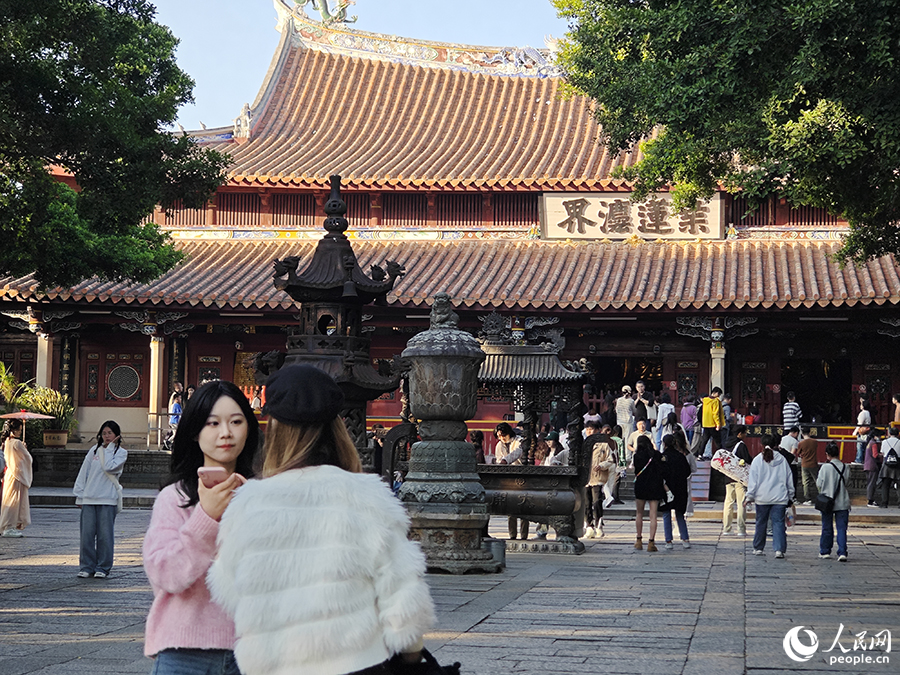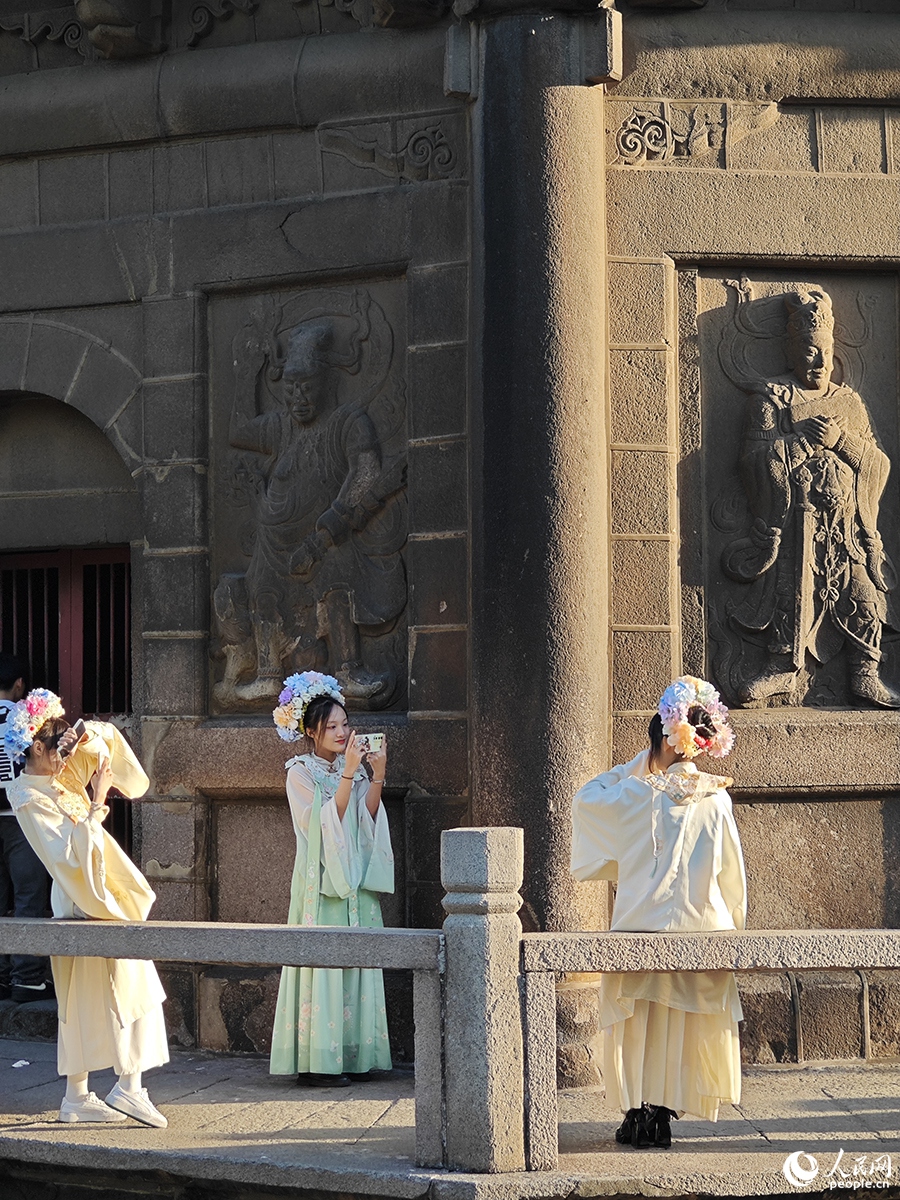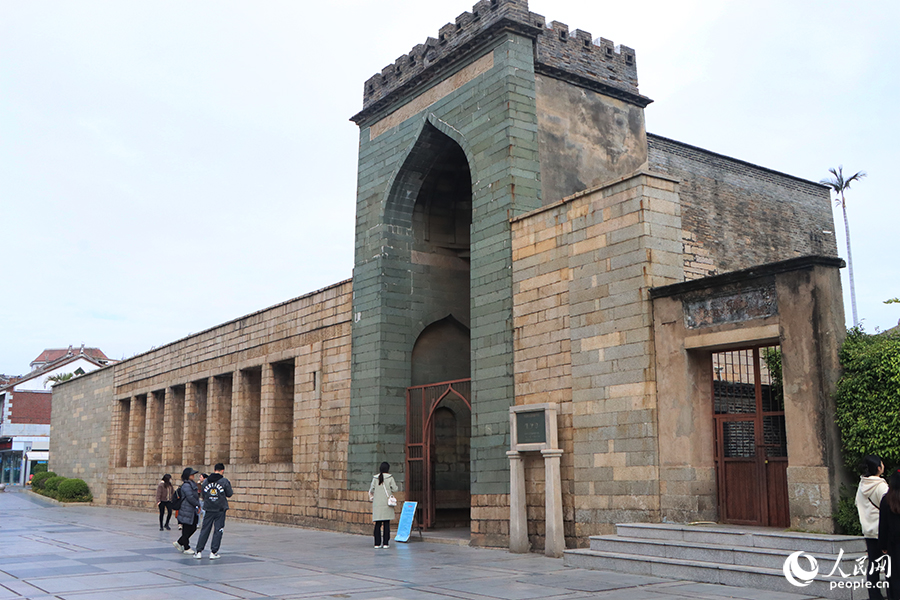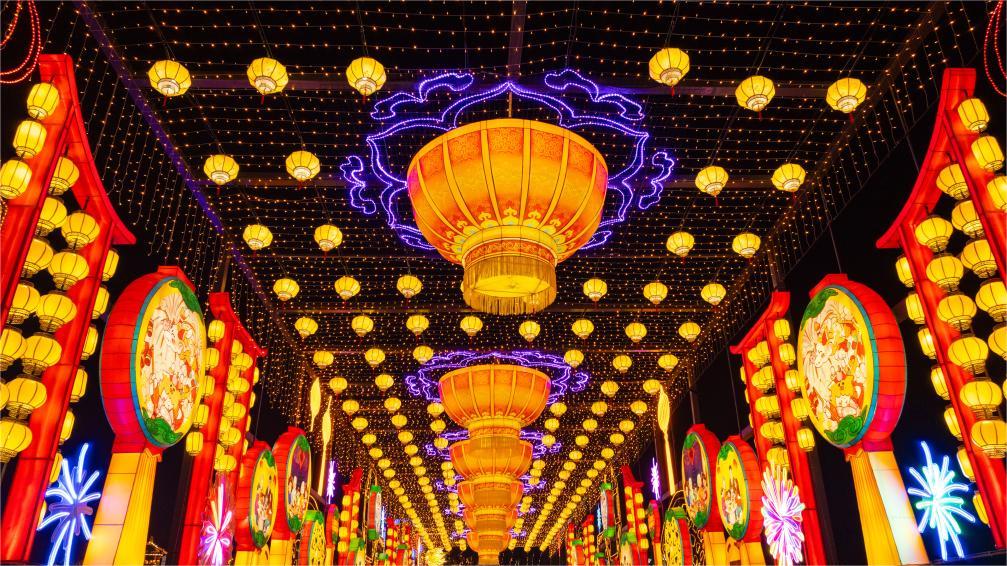In pics: 22 World Heritage sites in SE China's Quanzhou
The total tourism revenue of Quanzhou, designated as a "World Heritage City" by UNESCO, in southeast China's Fujian Province, soared 68.9 percent year on year at 100.24 billion yuan ($14.15 billion) in 2023, surpassing 100 billion yuan for the first time, according to official data.
The city is preparing for the upcoming Spring Festival holiday, which usually sees a tourism boom.
Let's take a virtual tour of the 22 World Heritage sites, which are must-sees, in Quanzhou.
1. Jiuri Mountain Wind-Praying Inscriptions
The Jiuri Mountain Wind-Praying Inscriptions, which are cliff inscriptions, record the prayer rituals for the safe voyages of ocean-going merchant ships in the Song Dynasty (960-1279). The ceremonies were held by state commissioners, local officials and members of the imperial clan in charge of overseas trade in the dynasty. The inscriptions reflect the state's power under the Song Dynasty's maritime trade system to promote and manage maritime trade.

Photo shows the Jiuri Mountain Wind-Praying Inscriptions in Quanzhou, southeast China's Fujian Province. (Photo/Cheng Dongdong)
2. Site of Maritime Trade Office
The Maritime Trade Office was an administrative agency established by the national regimes of the Song and Yuan (1271-1368) dynasties in Quanzhou to manage maritime trade affairs.

Photo shows a bird's-eye view of part of the archaeological excavation site of the Site of Maritime Trade Office in Quanzhou, southeast China's Fujian Province. (Photo/Wang Jun)
3. Site of Deji Gate
The Site of Deji Gate was the remains of the southern gate of the old city of Quanzhou in the Song and Yuan dynasties. The gate was a landmark in the commercial district on the southern side of the city. It bears testimony to the history of Quanzhou's southward expansion, reflecting the government's administrative guarantee for the development of maritime trade and commerce within the city.

Photo shows the Site of Deji Gate in Quanzhou, southeast China's Fujian Province. (People's Daily Online/Huang Dongyi)
4. Tianhou Temple
The Tianhou Temple was the first stop for foreign merchants and goods entering Quanzhou city. It was also the first stop for seafarers heading to the Estuary Docks or the Shihu Dock along the Jinjiang River to engage in maritime trade after paying their homage to Mazu, the sea goddess.

Photo shows the Tianhou Temple in Quanzhou, southeast China's Fujian Province. (People's Daily Online/Huang Dongyi)
5. Zhenwu Temple
The Zhenwu Temple, a Taoist temple dedicated to the worship of the Taoist deity, the Great Emperor Zhenwu, used to be a significant landmark of the ancient port of Fashi.

Photo shows the Zhenwu Temple in Quanzhou, southeast China's Fujian Province. (Photo/Chen Yingjie)
6. Site of the Southern Clan Office
The Southern Clan Office was an administrative agency established in the Jianyan period (1127-1130) of the Southern Song Dynasty (1127-1279) for imperial clansmen who relocated to Quanzhou.

Photo shows the Site of the Southern Clan Office in Quanzhou, southeast China's Fujian Province. (Photo/Cheng Dongdong)
7. Confucius Temple
The Confucius Temple and School embodied Quanzhou's intellectual and political elites. These social elites played a vital role in promoting and administering maritime trade during the Song and Yuan dynasties.

Photo shows the Confucius Temple in Quanzhou, southeast China's Fujian Province. (People's Daily Online/Huang Dongyi)

A girl poses for photos in front of the Dacheng Hall of the Confucius Temple in Quanzhou, southeast China's Fujian Province. (People's Daily Online/Huang Dongyi)
8. Kaiyuan Temple
The Kaiyuan Temple was the largest and highest government-sanctioned Buddhist temple in Quanzhou in the Song and Yuan dynasties.

Photo shows the Kaiyuan Temple in Quanzhou, southeast China's Fujian Province. (People's Daily Online/Huang Dongyi)

Tourists take photos of the east and west pagodas of the Kaiyuan Temple in Quanzhou, southeast China's Fujian Province. (People's Daily Online/Huang Dongyi)

Tourists take photos under the Zhenguo Pagoda, one of the two pagodas of the Kaiyuan Temple in Quanzhou, southeast China's Fujian Province. (People's Daily Online/Huang Dongyi)
9. Statue of Lao Tze
This massive stone statue of Lao Tze, founder of Taoism, is China's largest extant Taoist stone statue.

Photo shows the Statue of Lao Tze in Quanzhou, southeast China's Fujian Province. (Photo/Chen Yingjie)
10. Qingjing Mosque
The Qingjing Mosque is one of the few mosques built with granite and diabase in China, displaying the distinctive characteristics of a West Asian Islamic mosque.

Photo shows the Qingjing Mosque in Quanzhou, southeast China's Fujian Province. (People's Daily Online/Huang Dongyi)
11. Islamic Tombs
The tombs are among the earliest pieces of physical evidence of the introduction of Islam into China.
According to the "Annals of Fujian,” four disciples of Mohammed were sent to preach Islam in China in the Wude period (618-626) of the Tang Dynasty (618-907): the first to Guangzhou, the second to Yangzhou, and the third and the fourth to Quanzhou. The two missionaries were buried on the southern foothill of Lingshan Mountain, 2 kilometers away from the East Gate of Quanzhou.

Photo shows the Islamic Tombs in Quanzhou, southeast China's Fujian Province. (Photo/Cheng Dongdong)
12. Statue of Mani in Cao'an Temple
The Statue of Mani in Cao'an Temple is the only extant statue of the founder of the Manichaean religion in the world.

Photo shows the Statue of Mani in Cao'an Temple in Quanzhou, southeast China's Fujian Province. (Photo/Cheng Dongdong)
13. Sites of Cizao Kilns (Jinjiaoyi Hill Kilns)
These sites are outstanding examples of the export-porcelain kiln sites that dotted the outskirts of Quanzhou in the Song and Yuan dynasties. They demonstrate the prominence of craft production for export in the industrial structure of Quanzhou.

Photo shows the Sites of Cizao Kilns (Jinjiaoyi Hill Kilns) in Quanzhou, southeast China's Fujian Province. (Photo/Cheng Dongdong)
14. Sites of Dehua Kilns
The Dehua Kilns are one of the places of origin of Chinese porcelain culture, occupying an important position in the history of Chinese porcelain.

Photo shows the Weilin Kilns, part of the Sites of Dehua Kilns, in Quanzhou, southeast China's Fujian Province. (Photo/Liu Zongheng)
15. Xiacaopu Iron Production Site of Qingyang village in Anxi
This site bears invaluable testimony to the iron production industry of Quanzhou in the Song and Yuan dynasties. Together with Quanzhou's porcelain production bases, the site demonstrates Quanzhou's remarkable production and overseas trade capacity in the Song and Yuan dynasties.

Photo shows the Xiacaopu Iron Production Site of Qingyang Village in Anxi county, Quanzhou, southeast China's Fujian Province. (Photo/Li Jiasheng)
16. Luoyang Bridge
The Luoyang Bridge was a historical milestone in the development of Quanzhou's transportation network and a transportation hub connecting Quanzhou with northern Fujian and the nation's vast heartland.
It marked the start of three centuries of bridge building in Quanzhou during the Song and Yuan dynasties, promoting the establishment and improvement of the national port's water-land transshipment system.

Photo shows the Luoyang Bridge in Quanzhou, southeast China's Fujian Province. (Photo/Ye Xiaofeng)
17. Anping Bridge
The Anping Bridge is located 30 kilometers southwest of Quanzhou city in a bay at the juncture between Anhai town in Jinjiang, a county-level city overseen by Quanzhou, and Shuitou town in Nan'an, another county-level city overseen by Quanzhou.
The bridge was the main link between Quanzhou and Zhangzhou and Guangzhou to the south. It is also known as the Wuli Bridge, as its length is about 5 li (1 li is equal to around 500 meters). It is China's longest extant flat-beam sea-crossing stone bridge.

Photo shows the Anping Bridge in Quanzhou, southeast China's Fujian Province. (Photo courtesy of the cultural relic protection center of Jinjiang city)
18. Site of Shunji Bridge
This bridge was the node of land transportation between the old city of Quanzhou and the southern bank of the Jinjiang River. Built amid the rising maritime trade, it was the main access to the ancient commercial district in Quanzhou. The bridge reflected the improvement of the land-water transshipment system in Quanzhou.

Photo shows the Site of Shunji Bridge in Quanzhou, southeast China's Fujian Province. (Photo/Cheng Dongdong)
19. Estuary Docks
Since the Song and Yuan dynasties, Quanzhou had built along its waterways a series of navigation markers and docks to guide ships. The shipping facilities in the inner ports, outer ports and the outer sea had different functions and characteristics. Two docks of the Song and Yuan dynasties - Wenxing and Meishan - have been preserved.

Photo shows the Meishan Dock, part of the Estuary Docks, during sunset in Quanzhou, southeast China's Fujian Province. (Photo/Cheng Dongdong)
20. Shihu Dock
The Shihu Dock utilized natural reefs in its construction. It is an invaluable piece of physical evidence of Quanzhou's outer port docks, proving that conditions in Quanzhou in the Song and Yuan dynasties were highly conducive to port construction. This dock, together with the Estuary Docks, demonstrates the water-land transshipment system of the Quanzhou Port during the Song and Yuan dynasties.

Photo shows the Shihu Dock in Quanzhou, southeast China's Fujian Province. (Photo/Chen Yingjie)
21. Liusheng Pagoda
The Liusheng Pagoda was the landmark for merchant ships sailing from the main channel in Quanzhou Bay to inner ports. It is believed to provide divine protection for traveling merchants.

Photo shows the Liusheng Pagoda in Quanzhou, southeast China's Fujian Province. (Photo/Wu Wenbin)
22. Wanshou Pagoda
The Wanshou Pagoda served as an important navigation marker among the heritage sites that bore witness to Quanzhou's long maritime history.

Photo shows the Wanshou Pagoda during sunset in Quanzhou, southeast China's Fujian Province. (Photo/Jia Fushan)
Photos
 In pics: light installations for 30th Int'l Dinosaur Lantern Show in Zigong, SW China
In pics: light installations for 30th Int'l Dinosaur Lantern Show in Zigong, SW China Snow scenery at section of Wushan Mountain in China's Chongqing
Snow scenery at section of Wushan Mountain in China's Chongqing Pic story: young entrepreneur contributes to scientific visualization in China's Anhui
Pic story: young entrepreneur contributes to scientific visualization in China's Anhui Breathtaking 'blue tears' light up coastal waters in China's Guangdong
Breathtaking 'blue tears' light up coastal waters in China's Guangdong
Related Stories
- Dive into an audio journey in SE China's Quanzhou
- Quanzhou, a treasure trove of cultural heritage
- Oyster shells' voyage from Africa's east coast to China
- Explore Quanzhou, a port city along the Maritime Silk Road
- Explore the vibrancy of SE China's Quanzhou
- Trending in China | Savor the diverse culinary flavors of Quanzhou
Copyright © 2024 People's Daily Online. All Rights Reserved.





